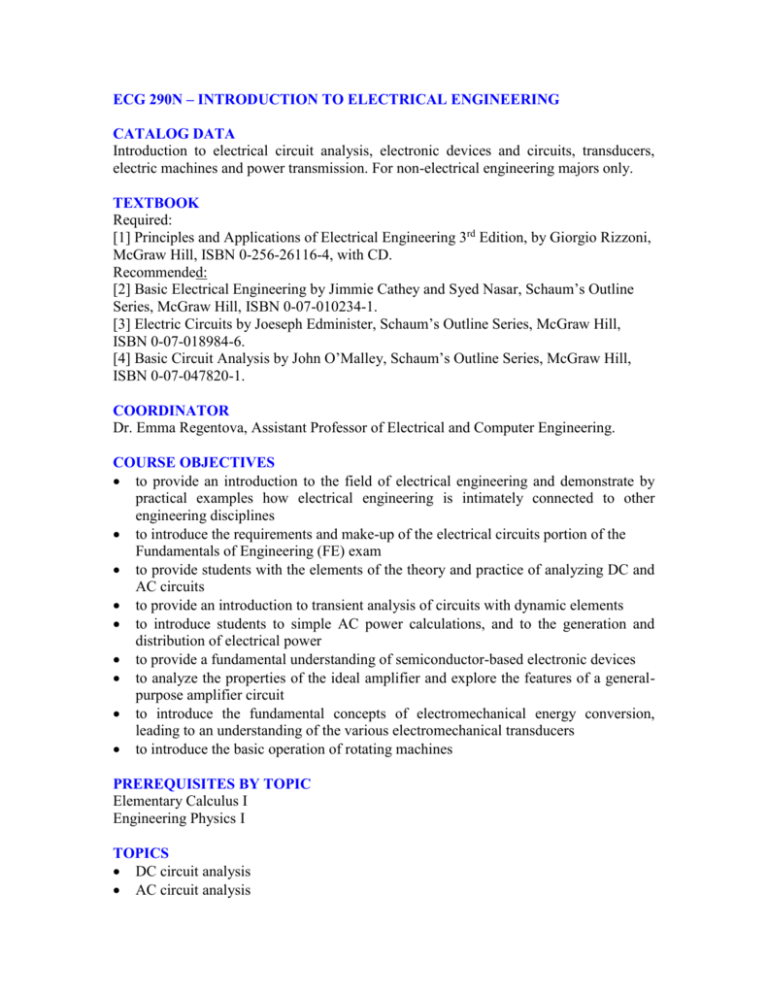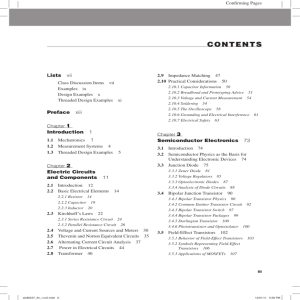ECG 290 – INTRODUCTION TO ELECTRICAL ENGINEERING
advertisement

ECG 290N – INTRODUCTION TO ELECTRICAL ENGINEERING CATALOG DATA Introduction to electrical circuit analysis, electronic devices and circuits, transducers, electric machines and power transmission. For non-electrical engineering majors only. TEXTBOOK Required: [1] Principles and Applications of Electrical Engineering 3rd Edition, by Giorgio Rizzoni, McGraw Hill, ISBN 0-256-26116-4, with CD. Recommended: [2] Basic Electrical Engineering by Jimmie Cathey and Syed Nasar, Schaum’s Outline Series, McGraw Hill, ISBN 0-07-010234-1. [3] Electric Circuits by Joeseph Edminister, Schaum’s Outline Series, McGraw Hill, ISBN 0-07-018984-6. [4] Basic Circuit Analysis by John O’Malley, Schaum’s Outline Series, McGraw Hill, ISBN 0-07-047820-1. COORDINATOR Dr. Emma Regentova, Assistant Professor of Electrical and Computer Engineering. COURSE OBJECTIVES to provide an introduction to the field of electrical engineering and demonstrate by practical examples how electrical engineering is intimately connected to other engineering disciplines to introduce the requirements and make-up of the electrical circuits portion of the Fundamentals of Engineering (FE) exam to provide students with the elements of the theory and practice of analyzing DC and AC circuits to provide an introduction to transient analysis of circuits with dynamic elements to introduce students to simple AC power calculations, and to the generation and distribution of electrical power to provide a fundamental understanding of semiconductor-based electronic devices to analyze the properties of the ideal amplifier and explore the features of a generalpurpose amplifier circuit to introduce the fundamental concepts of electromechanical energy conversion, leading to an understanding of the various electromechanical transducers to introduce the basic operation of rotating machines PREREQUISITES BY TOPIC Elementary Calculus I Engineering Physics I TOPICS DC circuit analysis AC circuit analysis Transient Analysis AC power Semiconductors and Diode description and operation Transistor fundamentals Introduction to operational amplifiers Principles of electro mechanics Electric machines: Principles of operation of DC and AC motors and generators COURSE OUTCOMES Upon completion of this course, students should be able to: analyze and solve passive AC and DC circuits apply transient analysis techniques to determine solutions for circuits containing dynamic elements know AC power calculations and residential wiring basics use diode models to design and analyze practical diode circuits understand transistor operation and use data sheets to analyze practical transistor circuits analyze and solve operational amplifier circuits that are used as filters, integrators, and differentiators analyze simple magnetic circuits explain operations of AC and DC motors and characterize them COMPUTER USAGE Electronics WorkBenchTM, Virtual lab with the provided CD DESIGN CONTENT None CLASS SCHEDULE Lecture 3 hours per week PROFESSIONAL CONTRIBUTION Engineering Science: 3.0 credits Engineering Design: 0.0 credits RELATIONSHIP BETWEEN COURSE AND PROGRAM OUTCOMES These course outcomes fulfill the following program objectives: COURSE PREPARER AND DATE OF PREPARATION Richard Hughes, 10 May 2002 (version 1).











